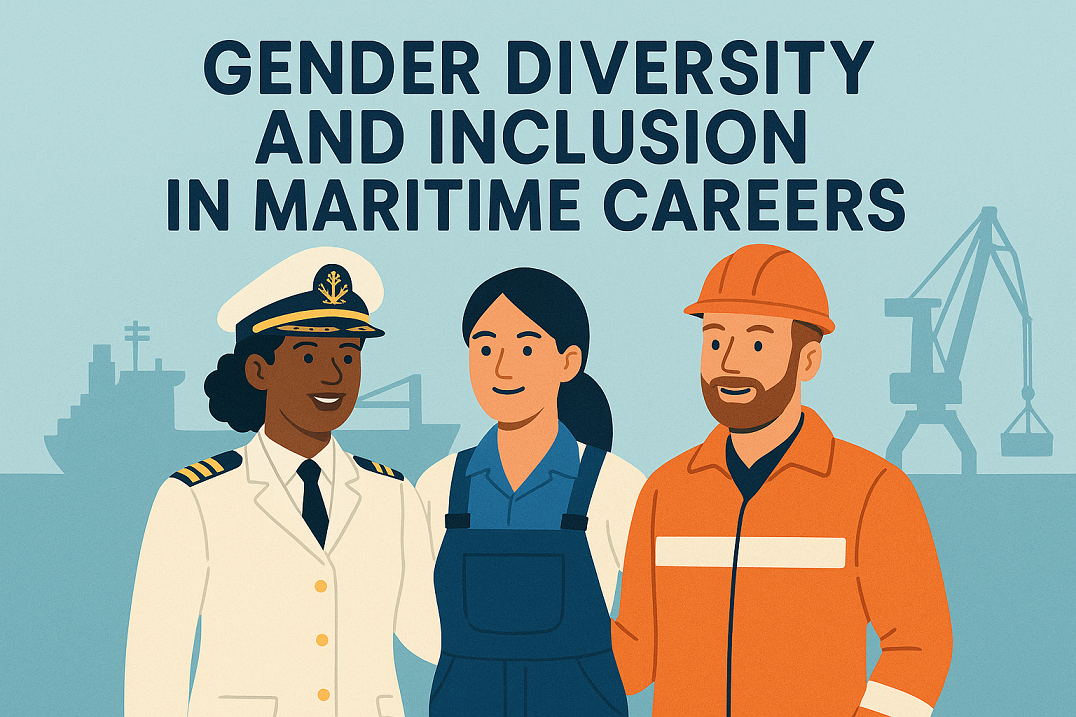Breaking the Tide of Tradition
Imagine standing on the deck of a ship, navigating vast oceans, leading a crew through shifting tides and global trade routes. Until recently, this leadership image seldom featured a woman. For centuries, the maritime world was a man’s domain—steeped in tradition, stereotypes, and barriers. But times are changing.
Today, women are increasingly taking the helm, both literally and figuratively. From India’s leap in female cadet enrollment to global campaigns like Maersk’s Equal At Sea, the maritime industry is embracing gender diversity like never before.
This article dives deep into the progress, challenges, and transformative efforts creating a more inclusive future in maritime careers.
What is Gender Diversity in the Maritime Sector?
Gender equality refers to the fair representation and inclusion of individuals of both male and female genders across roles, ranks, and responsibilities in the maritime industry. Historically, women were underrepresented due to systemic barriers, societal norms, and harsh working conditions.
Why It Matters:
-
Innovation & Growth: Diverse teams drive better decision-making and innovation.
-
Workforce Sustainability: Meeting labour shortages with a wider talent pool.
-
Social Equity: Ensuring fair access to career opportunities at sea and ashore.
🌍 As per the International Maritime Organization (IMO), women make up only about 2% of the global seafaring workforce.
A Snapshot of Progress: Recent Data and Milestones
Global Outlook
-
IMO’s Push for Equality: Ongoing programs for women in seafaring and leadership roles.
-
Leadership Roles: Increasing visibility of women in port management, logistics, and marine engineering.
India’s Groundbreaking Leap
- In 2021, female enrollment among Nautical and Engineering cadets was 7.6%.
- By 2024, it soared to 45%—a record-breaking transformation.
- In 2023, India’s first all-female batch of marine engineers graduated and joined leading global fleets.
Key Initiatives Driving Gender Inclusion
1. ‘Equal At Sea’ – A.P. Moller – Maersk
- Goal: 50% female cadet intake by 2027.
- Actions: Equal hiring policies, leadership development, inclusive culture training.
2. IMO’s Women in Maritime Program
- Programs: Scholarships, mentorships, and fellowships through the World Maritime University (WMU).
- Impact: Regional support networks and gender advocacy platforms.
3. Indian Maritime University (IMU) Cadet Recruitment
- Focus: National outreach, scholarships, and female-led promotions.
- Result: Dramatic rise in enrollment and successful job placements.
Challenges Women Still Face at Sea
Despite progress, many hurdles remain:
1. Cultural Barriers and Stereotypes
- Persistent beliefs about physical capability and leadership.
- Male-dominated environments can foster exclusion or bias.
2. Safety and Harassment Concerns
- Long periods at sea raise safety and isolation concerns.
- Some firms now enforce zero-tolerance harassment policies and install anonymous grievance systems.
3. Work-Life Balance
- Extended contracts and offshore life hinder family planning and retention.
- Solution: Flexible rotations, shore-based assignments, and parental leave policies.
Best Practices for Creating an Inclusive Maritime Culture
Inclusive Recruitment & Career Support
- Gender-balanced hiring panels.
- Awareness campaigns in schools and colleges targeting young women.
Onboard Support and Safety
- Gender-sensitivity training for crews.
- Wellness programs (mental health support, ergonomic designs).
Advancing Women in Leadership
- Scholarships for Master’s-level maritime programs.
- Management training to transition female officers into top executive roles.
Case Study: The ‘SheFarers’ Initiative
Launched: 2021 by a top maritime firm
Objective: Place women in senior officer roles (e.g., Chief Officer, Chief Engineer)
Outcome by 2024:
-
120 women promoted
-
30% higher retention among female crew
-
Boosted morale: Positive shift in onboard culture
🎯 Surveys showed a 40% improvement in inclusivity ratings post-initiative.
Future Trends: Where is the Maritime Industry Heading?
1. Digitalization & Automation
Smart ships reduce reliance on physical labor, opening doors for broader participation.
2. Global Collaborations
Joint efforts from IMO, shipping companies, and academic institutions.
3. Stronger International Policies
Push toward standardized anti-harassment rules, family-friendly policies, and equal pay enforcement across flags.
FAQs: People Also Ask
🔹 How many women are in the maritime industry?
About 2% of the seafaring workforce globally are women, according to the IMO.
🔹 What is Maersk’s ‘Equal At Sea’ initiative?
A gender diversity campaign aiming for 50% female cadet intake by 2027, with equal job access and leadership development.
🔹 What challenges do women face at sea?
Common challenges include workplace stereotypes, safety concerns, and limited work-life balance.
🔹 How can the maritime sector support women?
By enforcing inclusive hiring, safety policies, and leadership development opportunities.
Conclusion: Navigating Toward an Inclusive Horizon
The maritime industry is on a course correction—toward a future where gender is not a barrier, but a strength. Thanks to global programs like Equal At Sea, the IMO’s Women in Maritime, and India’s remarkable cadet inclusion, real change is happening.
But the journey is ongoing.
To foster true equality, the industry must continue dismantling stereotypes, enhancing safety, and promoting women into leadership roles.
⚓ Explore further: If you’re a student, researcher, or professional interested in maritime diversity, check out resources from IMO, World Maritime University, or Maersk’s Gender Policy.
References & Further Reading
-
International Maritime Organization – Women in Maritime
-
A.P. Moller – Maersk – Equal At Sea
-
World Maritime University – WMU Fellowships
-
Indian Maritime University – IMU Programs
-
UN Women – Gender Equality Reports

